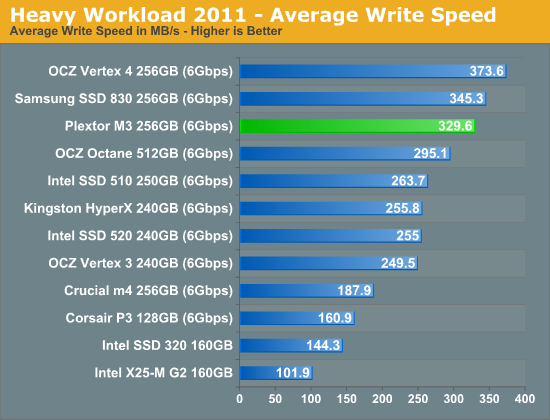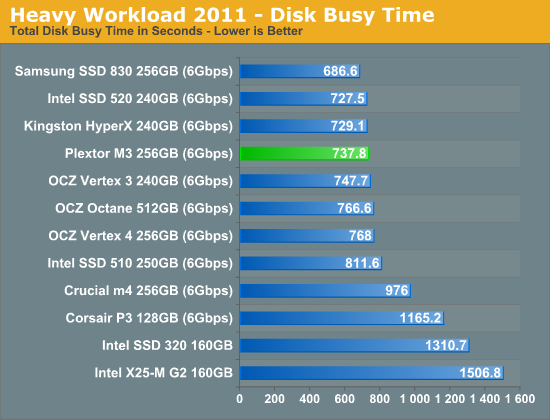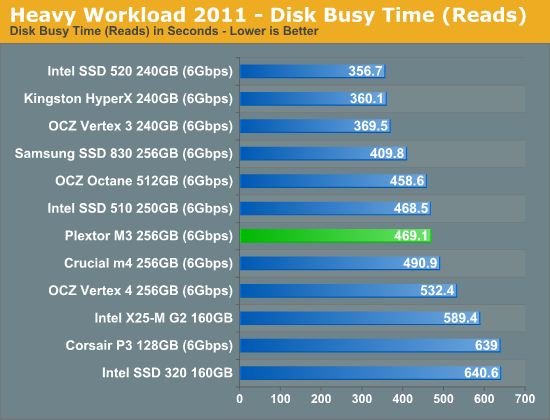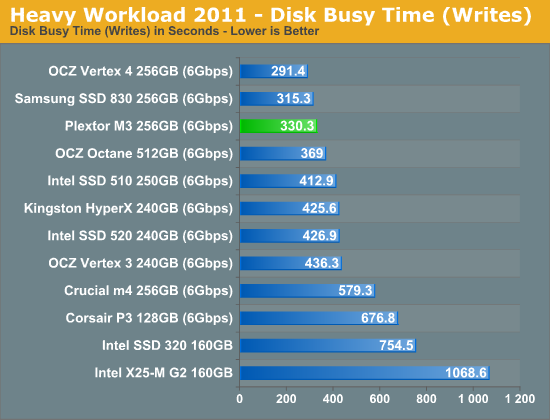The Plextor M3 (256GB) Review
by Kristian Vättö on April 5, 2012 3:05 AM ESTAnandTech Storage Bench 2011
Last year we introduced our AnandTech Storage Bench, a suite of benchmarks that took traces of real OS/application usage and played them back in a repeatable manner. Anand assembled the traces out of frustration with the majority of what we have today in terms of SSD benchmarks.
Although the AnandTech Storage Bench tests did a good job of characterizing SSD performance, they weren't stressful enough. All of the tests performed less than 10GB of reads/writes and typically involved only 4GB of writes specifically. That's not even enough exceed the spare area on most SSDs. Most canned SSD benchmarks don't even come close to writing a single gigabyte of data, but that doesn't mean that simply writing 4GB is acceptable.
Originally we kept the benchmarks short enough that they wouldn't be a burden to run (~30 minutes) but long enough that they were representative of what a power user might do with their system. Later, however, we created what we refer to as the Mother of All SSD Benchmarks (MOASB). Rather than only writing 4GB of data to the drive, this benchmark writes 106.32GB. This represents the load you'd put on a drive after nearly two weeks of constant usage. And it takes a long time to run.
1) The MOASB, officially called AnandTech Storage Bench 2011—Heavy Workload, mainly focuses on the times when your I/O activity is the highest. There is a lot of downloading and application installing that happens during the course of this test. Our thinking was that it's during application installs, file copies, downloading, and multitasking with all of this that you can really notice performance differences between drives.
2) We tried to cover as many bases as possible with the software incorporated into this test. There's a lot of photo editing in Photoshop, HTML editing in Dreamweaver, web browsing, game playing/level loading (Starcraft II and WoW are both a part of the test), as well as general use stuff (application installing, virus scanning). We included a large amount of email downloading, document creation, and editing as well. To top it all off we even use Visual Studio 2008 to build Chromium during the test.
The test has 2,168,893 read operations and 1,783,447 write operations. The IO breakdown is as follows:
| AnandTech Storage Bench 2011—Heavy Workload IO Breakdown | ||||
| IO Size | % of Total | |||
| 4KB | 28% | |||
| 16KB | 10% | |||
| 32KB | 10% | |||
| 64KB | 4% | |||
Only 42% of all operations are sequential; the rest ranges from pseudo to fully random (with most falling in the pseudo-random category). Average queue depth is 4.625 IOs, with 59% of operations taking place in an IO queue of 1.
Many of you have asked for a better way to really characterize performance. Simply looking at IOPS doesn't really say much. As a result we're going to be presenting Storage Bench 2011 data in a slightly different way. We'll have performance represented as Average MB/s, with higher numbers being better. At the same time we'll be reporting how long the SSD was busy while running this test. These disk busy graphs will show you exactly how much time was shaved off by using a faster drive vs. a slower one during the course of this test. Finally, we will also break out performance into reads, writes, and combined. The reason we do this is to help balance out the fact that this test is unusually write intensive, which can often hide the benefits of a drive with good read performance.
There's also a new light workload for 2011. This is a far more reasonable, typical every day use case benchmark. It has lots of web browsing, photo editing (but with a greater focus on photo consumption), video playback, as well as some application installs and gaming. This test isn't nearly as write intensive as the MOASB but it's still multiple times more write intensive than what we were running last year.
We don't believe that these two benchmarks alone are enough to characterize the performance of a drive, but hopefully along with the rest of our tests they will help provide a better idea. The testbed for Storage Bench 2011 has changed as well. We're now using a Sandy Bridge platform with full 6Gbps support for these tests.
AnandTech Storage Bench 2011—Heavy Workload
We'll start out by looking at average data rate throughout our new heavy workload test:

Samsung SSD 830 continues to dominate our Heavy suite but in both read and write, but the M3 is the fastest Marvell based SSD and delivers a result 32% faster than the Crucial m4. Overall the M3 is on-par with SandForce—it does worse in read speed but takes that back in write speed.


The next three charts just represent the same data, but in a different manner. Instead of looking at average data rate, we're looking at how long the disk was busy for during this entire test. Note that disk busy time excludes any and all idles; this is just how long the SSD was busy doing something:













113 Comments
View All Comments
magnetar - Saturday, April 7, 2012 - link
... that the Intel 510 SSD also uses the Marvell 9174 controller. I'm pleased that the 510 is still included in many SSD reviews at AnandTech, although it is dismissed as old and slow by some enthusiasts.The Samsung SSD Magician is the "gold standard" of SSD support programs? Personally I prefer Intel's SSD Toobox, the 3.0 version of course. I use both, and they are excellent, I've never had a problem with either of them. I like Intel's Toolbox UI over Samsung's Magician, the latter running in the background when not in use for some reason. Magician has more functions than the Toolbox, so has it beat in that aspect. Both allow firmware updates in the Windows environment... priceless!
LokutusofBorg - Saturday, April 7, 2012 - link
Yeah, I noticed this too. That part of the article should be updated to say "Intel's 510 and 520 series..." or some such.sunsin - Saturday, April 7, 2012 - link
Kristian, I compared the result with Intel SSD 520Intel SSD 520 240GB Clean 284.5 MB/s After Torture 162.9 MB/s After TRIM 162.9 MB/s
Plextor M3 256GB Clearn 328 MB/s After Torture 302.1 MB/s After TRIM: 327.1 MB/s
The Plextor M3 has way better performance than Sandforce based SSD where the TRIM will never restore the clean performance. This does mean that Plextor will be better option for long term use.
In addition, you mentioned that Sandorce based SSD will be a better choice for OS without official TRIM support, please provide some comparative figure to support this. The After Torture performance for Plextor vs Sandforce can be 302.1 vs 162.9 MBs. The win by 80%. Please explain why you always suggest Sandforce based SSD For OS without TRIM?
Kristian Vättö - Saturday, April 7, 2012 - link
First off, we use different methods for TRIM testing on SF and non-SF drives. Non-SF drives are filled and tortured with compressible data as that is what HD Tach uses. SF drives, on the other hand, are filled and tortured with incompressible data and then benchmarked with AS-SSD which uses incompressible data as well. The length of the torture can vary as well. Hence you can't directly compare the results.In the case of Intel 520 and Plextor M3, Intel 520 was tortured for 60 minutes and it still managed a speed of 162.9MB/s. The numbers you have for Plextor are after 20 min torture. I also included a graph of 60min torture and the average write speed dropped to 54.9MB/s. Does this make sense to you now?
SandForce's advantage is extremely low write amplification: http://images.anandtech.com/graphs/graph5529/44082...
When you write less, there is also less garbage collection to do. Here is one graph that Anand linked earlier which compares TRIM/GC of drives: http://images.anandtech.com/graphs/graph5719/45462...
However, like I noted in the TRIM part, there should be absolutely no problem in running M3 in an OS without TRIM. IF you are an extreme user and you'll be constantly hammering the drive under OS with no official TRIM support, then a SandForce drive may be a better solution. Most people's workload isn't like that and any decent SSD should do the job.
I maintain a huge SSD sticky at MacRumors and I've only seen a few users complain about performance degradation, and nowadays we would consider those SSDs to be ancient anyway. Besides, if the performance degrades, you can always enable TRIM temporarily in OS X and TRIM the drive, then disable TRIM.
jwilliams4200 - Monday, April 9, 2012 - link
Note that the "Steady State 4KB Random Write Performance" graph has highly misleading results.The steady-state 4KB QD=32 random write performance of the Vertex 3 when tested with random data streams (as the industry-standard SNIA protocol specifies) is only about 30MB/s, not 159MB/s as anandtech.com's graph incorrectly shows. You can see the correct results in either of these reviews:
http://www.xbitlabs.com/articles/storage/display/m...
http://www.storagereview.com/plextor_pxm3p_ssd_rev...
It is disappointing for anandtech.com to get a simple test like this so very wrong.
kissfan003 - Saturday, April 7, 2012 - link
Plextor an unknown... Dang, I'm old... They were the best optical drive "back in my day"...ejiggyb - Sunday, April 8, 2012 - link
Plextor used to be the only one for me, way back when Adaptec software was the king. That became Roxio. I had 3 different models they all became junk after a little use. They would automatically change speed if i was ripping a CD down to 2 speed unless I held the open button for a few seconds before I put in the CD. I spent a pretty penny for all them. To bad, I was a huge fan.yyrkoon - Sunday, April 8, 2012 - link
"As far as brand awareness for Plextor, I believe the reason for their relative obscurity of late has been the lack of media awareness and contacts. Their journey to become an SSD manufacturer has been rather abnormal. When you think of the history of other SSD manufacturers, they were mostly known for RAM before entering the SSD world."While I wont argue that Plextor is/is not in the RAM business. Since when in the context of this article has Plextor been known for it's RAM products ? The general audience here being computer enthusiasts, and not Electronic Engineers. Even then, being in embedded design myself ( as a very serious hobby ) I can not say with all honesty that I have even heard of a Plextor memory chip/stick.
I think most/all power users that have been around over the last 10+ years would agree that Plextor is most noted for it's optical drives. Specifically the bit for bit copy models. Like another reader, I own a UW SCSI UltraPlex myself, and it is still going strong to this day. Though admittedly, it has not been very useful for years.
Kristian Vättö - Sunday, April 8, 2012 - link
I was specifically talking about other SSD manufacturers. Think e.g. OCZ and Crucial, both are RAM manufacturers. Plextor's journey is abnormal because they never made RAM or other components, only ODDs. I was not claiming that Plextor is a RAM manufacturer.yyrkoon - Sunday, April 8, 2012 - link
Ah ha. I see now. *Other* SSD manufactures . . My mistake.. Sorry.So looking at things from that perspective.
Plextor started off as the go to brand for many people where optical drives were concerned. Their CD writers / readers were second to none.. Often far exceeding the competition in performance, and features.
Now days, like anyone else. It seems Plextor is only interested in making throw-away ( reference design ) products. No more pride in the brand.
Going by the information given to us in your review, it seems perhaps Plextor is trying to put effort into at least this product, With great results ( so it seems ). Perhaps even trying to regain their good name of the past,
With the above said, I think I would have to give Plextor a pass. Simply because their recent track record says one thing to me( by recent i mean the last several years ). *Money*. Not the end user, not even their good reputation. That goes back to your comments about the cost as well.
Happily, I would love to be proven wrong. However, I would not hold my breathe passed 6 months where software support is concerned.
Thank you for your non condescending response Though, I probably deserved it heh.